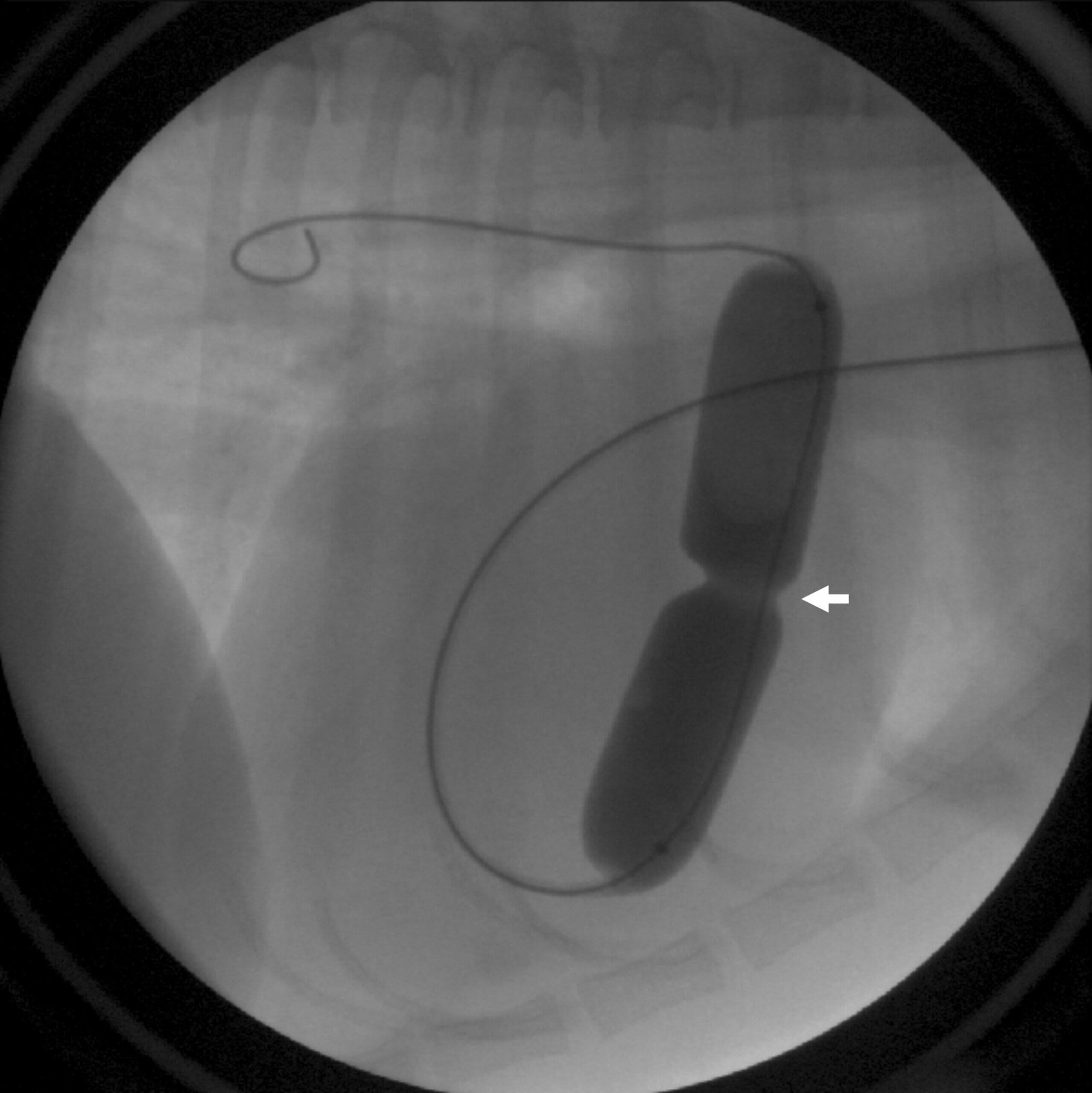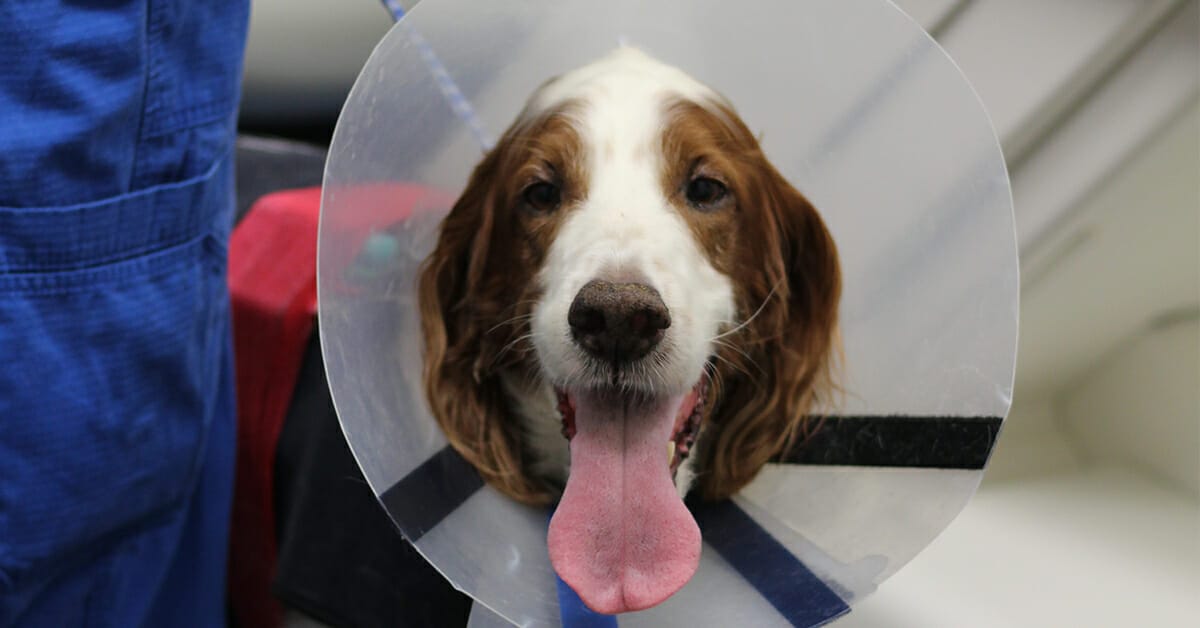
Tracheal Collapse in Dogs: Everything You Need to Know
The trachea, vital for dog breathing, has cartilage rings that keep it open. If these weaken, breathing issues can arise.
As a pet owner, it’s important to understand the role of the trachea in your dog’s respiratory system. The trachea is a flexible tube that has strong c-shaped rings of cartilage and muscle that extends from the throat to the lungs. These rings play a crucial role in keeping the trachea open, allowing air to flow in and out of the lungs, However, when these small cartilage rings weaken or become compressed, it can hinder your dog’s ability to breathe properly. This can lead to a variety of signs, including a harsh, dry cough that sounds like a “goose honk,” breathing difficulties, and wheezing.
What is Tracheal Collapse in Dogs?
Tracheal collapse in dogs happens when the cartilage rings of the trachea (windpipe) and smaller airways (bronchi), become weak and lose their rigidity. This results in the membrane connecting the “C” to become loose and saggy, causing the tracheal rings to flatten when air is being drawn in and out of the lungs, which makes it difficult for pets to breathe.
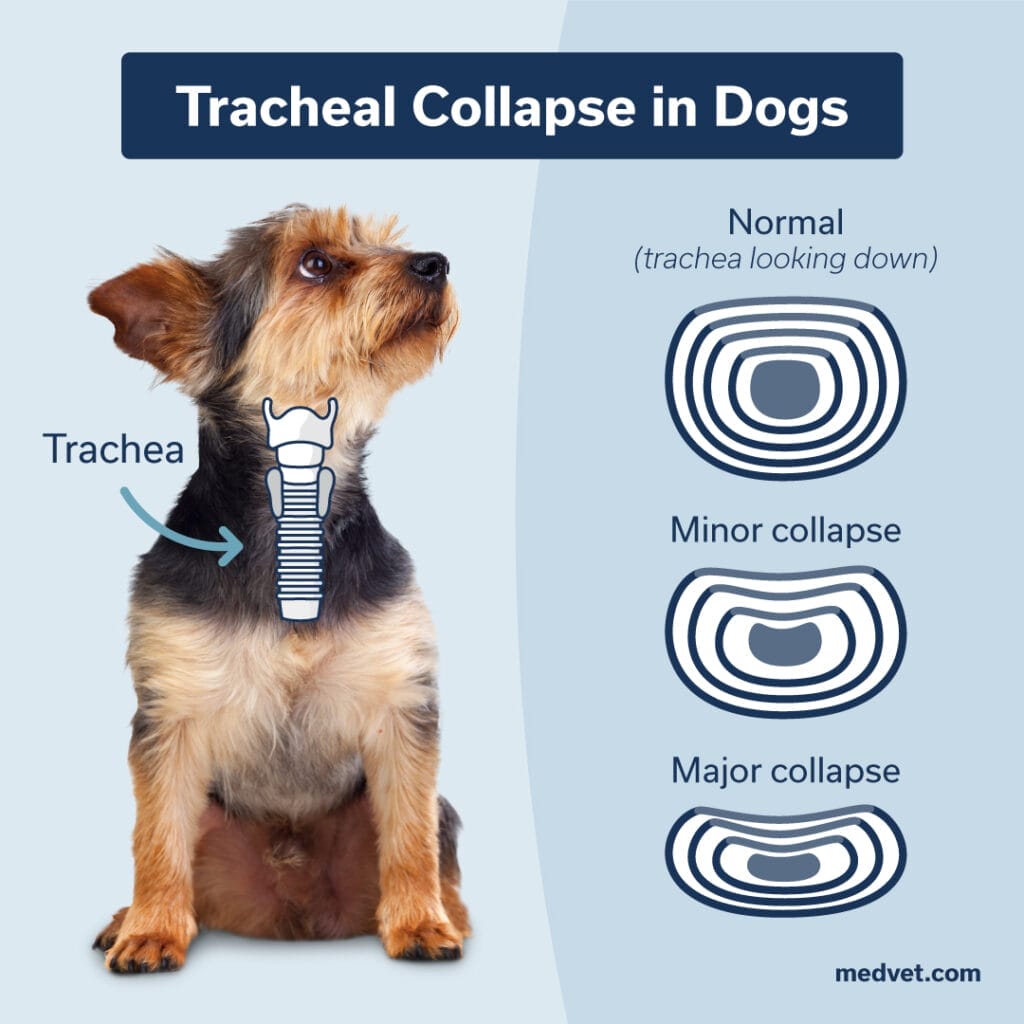
What Causes Tracheal Collapse in Dogs?
Chondromalacia is the primary cause of tracheal collapse, a condition that weakens the cartilage in the trachea. This degenerative process predominantly affects senior dogs and can be influenced by factors such as genetics, excessive weight, and persistent coughing: however, it can occasionally be seen as a congenital condition.
While tracheal collapse can affect dogs of all sizes and breeds, certain dog breeds are more susceptible to tracheal collapse due to their anatomical characteristics. Smaller breeds, particularly toy breeds such as Pomeranians, Yorkshire Terriers, Chihuahuas, Poodles, Pugs, and Maltese are more vulnerable to collapse.
Other factors that contribute to tracheal collapse in dogs include:
- Trauma: Injuries to the neck region can directly damage the trachea.
- Infections: Infections like dental disease, bronchitis and pneumonia can cause inflammation and weakening of the tracheal cartilage.
- Tumors: Whether benign or malignant, tumors can obstruct the airway and lead to tracheal collapse.
- Obesity: Being overweight exacerbates the risk of tracheal collapse by exerting undue pressure on the windpipe.
- Enlarged liver: This can restrict the movement of the diaphragm, increasing coughing.
Signs of Tracheal Collapse in Dogs
Tracheal collapse is a serious condition that can significantly affect a dog’s quality of life and, if left untreated, can even be fatal. Dog owners should be aware of the signs of this condition to ensure their pet receives prompt medical attention if needed.
One of the most common signs of tracheal collapse is a dry, hacking cough that sounds like a goose honking. This cough is often triggered by exercise, excitement, or pulling on the leash. Other respiratory signs may also be present, such as difficulty breathing, particularly after exertion, wheezing or noisy breathing, and retching or vomiting.
Dogs with tracheal collapse may also experience loss of appetite or weight loss. The compromised ability to breathe due to tracheal collapse can result in reduced energy levels and a decreased desire to eat.
If you observe any of these signs in your dog, take them to the veterinarian promptly. Early diagnosis and treatment of tracheal collapse can greatly improve the prognosis for dogs affected by this condition.
Diagnosing Tracheal Collapse in Dogs: What to Expect
When you bring your furry friend to the veterinarian with respiratory concerns, they will conduct a thorough examination to assess any signs of distress. This may include observing your dog’s breathing rate, checking for difficulty in breathing, and listening for any unusual sounds like wheezing or rattling. They will also carefully examine the neck and trachea for any abnormalities.
To confirm the diagnosis, the veterinarian may use various diagnostic testing, including:
- X-rays: These detailed images of the neck and chest can reveal if your dog has a collapsed trachea and other abnormalities that might be contributing to your dog’s respiratory issues.
- Fluoroscopy: This real-time imaging technique allows the veterinarian to observe the trachea as your dog breathes, helping them determine the exact location and severity of the tracheal collapse.
- Tracheoscopy: During this procedure, a small camera is inserted into the trachea to provide a direct visual examination of the inside of the airway. This can help identify any abnormalities, such as tumors or foreign objects, that may be causing the tracheal collapse.
In some cases, additional tests, such as blood work or a biopsy, may be necessary to rule out other conditions that may be causing your dog’s respiratory problems.
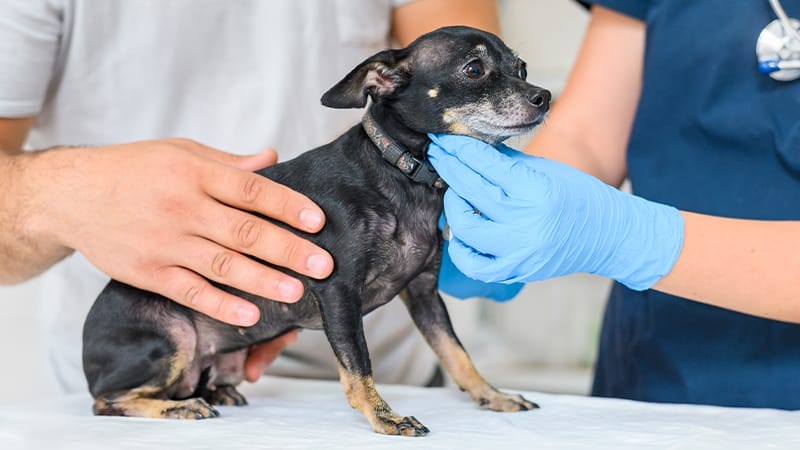
Treatment of Tracheal Collapse in Dogs
Although treatments are available for tracheal collapse, it is a condition your pet will live with for the remainder of their life, and it cannot be cured. The treatment approach for tracheal collapse in dogs depends on the severity of the condition and will always involve medication and lifestyle changes. If medical therapy is not working, then surgery or interventional therapy will be recommended.
- Medications: Your veterinarian will prescribe medications to help alleviate the signs and make breathing easier for your dog. Bronchodilators can relax the airway muscles, while inflammatory drugs like prednisone can reduce inflammation. Sedatives may also be used to minimize anxiety and stress, which can worsen tracheal collapse. Additionally, a cough suppressant can help reduce coughing, which can irritate the trachea and make breathing more challenging. Often, medications will be needed lifelong, even with surgical intervention.
- Lifestyle Changes: Making certain adjustments to your dog’s lifestyle can improve their breathing and reduce tracheal collapse signs.
- Supportive Measures: Using a harness instead of a collar can help support the trachea and alleviate pressure on it. This can be particularly beneficial during walks or other activities.
- Surgical Intervention: In severe cases of tracheal collapse, surgery may be necessary. There are various surgical procedures available, including the placement of a stent inside the trachea to provide support and prevent collapse. Another option involves surgically attaching plastic rings to the external surface of the trachea to maintain its rigidity and shape. Your veterinary surgeon and veterinary internist will discuss the surgical options and recommend the most suitable approach for your pet.
Remember, each dog is unique, and the treatment plan will be tailored to their specific needs. Your veterinarian will guide you through the available options and work with you to provide the best care for your beloved companion.
How to Help Your Dog at Home
If your dog has been diagnosed with tracheal collapse, there are steps you can take at home to assist them in managing their condition and enhancing their wellbeing.
- Minimize Excitement and Excessive Barking: Activities that excite your dog or lead to excessive barking can put strain on the trachea and worsen the
irsigns. It’s important to avoid such triggers to provide relief. You can do many of these exercises at home in a calm setting to keep your dog active, yet not triggered. - Be Mindful of Heat: Dogs with tracheal collapse are more susceptible to heatstroke. Therefore, it’s crucial to protect them from extreme heat and ensure they have access to shade and fresh water.
- Opt for a Harness: When walking your dog, use a harness instead of a collar. This helps distribute pressure more evenly and reduces strain on the trachea. Additionally, be cautious during activities like playing fetch or navigating stairs, as they can also exert pressure on the trachea.
- Maintain a Healthy Weight: Excess weight can exacerbate tracheal collapse signs by adding strain to the airway. If your dog is overweight, consult your veterinarian for a suitable weight loss plan to alleviate the burden on their trachea.
- Consider Using a Humidifier: Dry air can irritate the trachea and make breathing more challenging. Using a humidifier in your home can help keep the air moist, providing relief for your dog’s respiratory system. Airway irritants such as candles, smoke, and perfumes, etc. Can be very triggering to dogs with tracheal collapse.
Remember, these home care tips are meant to complement veterinary guidance and treatment. Regular communication with your veterinarian is essential to ensure your dog receives the best possible care and support for their tracheal collapse.
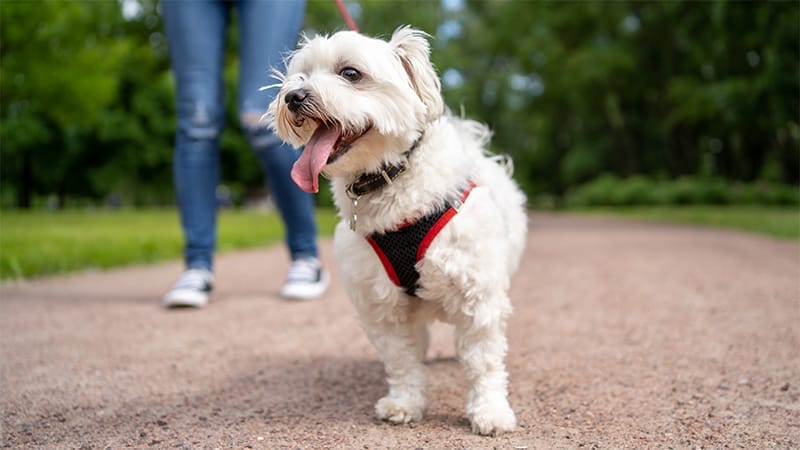
Understanding the Prognosis for Dogs with Tracheal Collapse
When it comes to the prognosis for dogs with tracheal collapse, several factors come into play, including the severity of the condition and its underlying cause. Dogs with tracheal collapse caused by congenital defects or injuries generally have a more favorable prognosis compared to those with tracheal collapse resulting from diseases like cancer, heart issues, or lung disease.
With appropriate treatment and attentive care, many dogs with tracheal collapse can lead fulfilling and extended lives. By closely monitoring their breathing, overall health, and scheduling regular veterinary check-ups, you can help your beloved pet thrive and maximize their quality of life for years to come.
Find a MedVet location that can treat your pet’s respiratory issues.
Contents


